What’s the best part of setting up a saltwater aquarium? Picking our you fish! And while you have the entire ocean (okay, not the ENTIRE ocean) to choose from, some fish make better starter fish than others. Because if you’ve never managed a marine tank before, you could find yourself struggling to meet the demands of some of the more difficult species out there. Of course, these fish don’t advertise the fact that they’ll bring you to your knees with their challenges. Good thing I’ve put together this list of the top five fish you’ll want to AVOID at all costs!
Table of Contents
Now, you CAN use these links to skip down to the fish and find out why they make such terrible starter fish. Or you can read through the entire article to get a thorough understanding of what makes a good fish for beginners (or not). The choice is yours.
- What is a Starter Fish?
- Qualities of Good Starter Fish
- Top 5 Starter Fish to Avoid
- For More Information
What is a Starter Fish?
When you set up a saltwater fish tank, the first fish you put in the tank are considered starter fish. But most aquarists use the term “starter fish” to refer to the best fish to add when first setting up a saltwater tank.
An unfortunate reality when starting out in the saltwater aquarium hobby is that the first few fish you add to the tank? May not live. This phenomenon is called “new tank syndrome.” The two biggest causes of new tank syndrome are ammonia toxicity and fluctuations in water parameters. Filters don’t adequately clear the waste produced in a brand new tank, regardless of how fancy they are or how many you have installed. And the resulting waste can become toxic and take the life of the fish.
So the recommendation is to look for fish able to tolerate the less-than-perfect living conditions of a new tank. (Not that you should slack off on your cycling. You’re just aiming for species that are a little more forgiving of initial slip-ups and mistakes) Are all cool saltwater fish great starter fish? Of course not. You won’t even find all hardy fish working out for beginners. It’s a careful balance of key qualities.
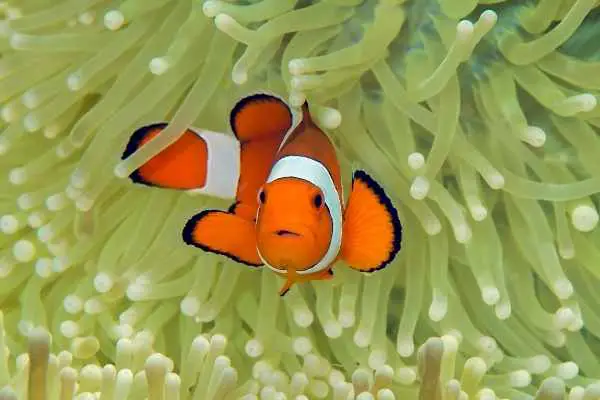
Qualities of a Good Starter Fish
When you set out to stock your tank with those first finny residents, you’re looking at six key criteria. If they meet all of these qualities? Then you have a starter fish that should survive the ups and downs of the tank settling. Let’s break down each of the characteristics:
Hardiness
You want a starter fish that can tolerate harsh and possibly fluctuating aquariums. After all, the odds are that (even with proper cycling) conditions will change as you add new additions to the aquarium. Delicate species that need water conditions to remain steady? They’re not going to make it. You want a tolerant species that won’t mind you experimenting with things. (Again, this is NOT a substitute for having a cleaning routine and proper filtration)
Resistant to Parasites
Certain fish species seem more prone to contracting life-threatening parasite infections like saltwater ich (white spot disease) or Amyloodinium (marine velvet) than others. The LAST thing you want to deal with is an infestation of parasites while you’re getting all of your water parameters straight. (And, you know, picking your fish and other invertebrates) That means choosing starter fish that AREN’T likely to have parasites piggy-backing along for the ride. You still want to do a quarantine, of course, but it’ll go by in a snap.
Inexpensive
Saltwater fish can cost anywhere from a few dollars to a few HUNDRED dollars. It should go without saying that a good starter fish shouldn’t break the bank. Things can still go wrong with these fish, and you don’t want to throw away your investment. That doesn’t mean you should pick the cheapest fish possible, though. You can end up with some pretty sickly options going that route. But inexpensive species make sense when you’re still getting your feet wet. Once you have more experience, you can aspire to truly mythic options.
Compatibility
Since your starter fish will be the FIRST fish you put in your tank, you want peaceful species. This means fish that aren’t going to get partial about territories or end up with aggression issues. Otherwise, as soon as you start to build on your marine aquarium, you’ll end up with problems. Those first little fishy friends can turn into bullies. They may harass your new fish, sometimes to the point of starvation. Go for the sweethearts first. You can always add some brutes in down the line.
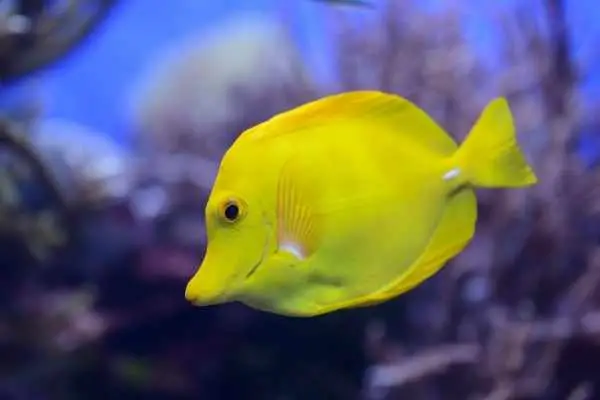
Vibrance
Obviously, the size of your tank will limit the number of fish and coral you can add. And while you can always purchase a larger tank down the road, why start thinking about that NOW? Make every fish you add to a display aquarium count. So find those species with the best colors and patterns. Sure, you can find starter fish without any sparkle, but why do you want to go down that road? You shouldn’t start with a plan for the tank to fail. Pick out species that catch the eye and draw attention.
Check out these popular stocking guides to get a detailed recommendation for your tank:
Starter Fish Should be Interesting
Good starter fish should be INTERESTING. Different species each have different personalities, and you want to pick a great variety. Some are timid, some are bold, some are fast swimmers, some seem to “waddle” around on their fins. Find the fish that speaks to YOU. The more interested you are – for whatever reason – the more time and energy you’ll invest into your aquarium. And that’s going to result in a better display and health for your fish. Plus, you’ll uncover plenty of nifty tidbits about the fish you can share with everyone that drops by – whether they wanted to know or not!
Top 5 Starter Fish to Avoid
Despite having a handy guide on what makes a solid starter fish or not, sometimes aquarists choose species better off avoided. Maybe something caught their eye (that “vibrancy” characteristic usually tops most people’s lists on what they look for in an aquarium fish). Suddenly, they’re struggling to manage a difficult fish that wants to die every time they turn around.
Or perhaps they received a recommendation from another aquarist on an interesting species. But now they have a tyrant beating up everyone else in the tank. (Or worse, EATING the others)
This is why it’s important to do your homework and make sure the starter fish you’re interested in checks ALL of those boxes. And it’s why I’ve compiled this list of five of the WORST fish you could add to a beginning tank. (So I did some work for you)
Mandarinfish
Aquarists love mandarinfish, also known as dragonets. These slow-moving, psychedelic fish are some of the most vibrant fish you can find at your local fish store. And, in all seriousness, they DO meet a few of the criteria important in a good starter fish:
- As small fish, they won’t outgrow your tank
- They’re parasite and disease-resistant
- They’re generally inexpensive
But when it comes to the hardiness test, they fail miserably. Mandarinfish are NOTORIOUSLY picky eaters. They specialize in eating copepods (tiny invertebrates), and they’ll shun other foods normally offered by beginners. Unless you can provide a healthy, sustainable population of copepods, your mandarinfish will starve to death.

Cleaner Wrasses
Compared with the docile, slow-swimming mandarinfish, cleaner wrasses zip around aquariums in constant motion. And, as cleaners, these wrasses will clean other fish in the tank, removing dead scales and harmful parasites. It’s that interesting behavior – coupled with their vibrant colors – that makes them appealing to aquarists. After all, since saltwater ich is such a major problem for new saltwater tanks, adding these helpful fish seems like a brilliant idea. But I’m here to tell you to avoid these fish. They are NOT good starter fish.
Cleaner wrasses will most likely starve in your aquarium. The ONLY food they will eat is the food they pick off of other fish. And since you’re working to keep a parasite-free environment, there won’t be enough parasites to feed them. Even an established tank can struggle to keep these helpful little fish satisfied. So save your money (they’re not cheap), save a life, and pick a different fish to start your tank.
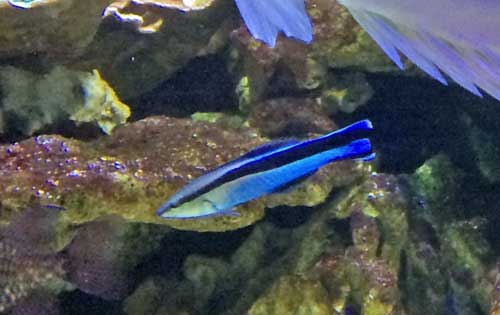
Panther Groupers
When you see groupers in your local fish store, they’re usually small, cute, and interesting. (That checks three boxes on the starter fish list) And most of the species you encounter in your local fish store even manage the hardiness score. So that brings your scorecard up to four. But panther groupers are a major no-no.
Groupers will eat almost anything alive that will fit in their mouths. And their mouths grow quite large. Oh, sure, they start out small and manageable. But they grow FAST. And unless you have a tank that is 200 gallons (757L) or larger AND you plan on keeping other huge, aggressive fish, groupers need to get passed over.
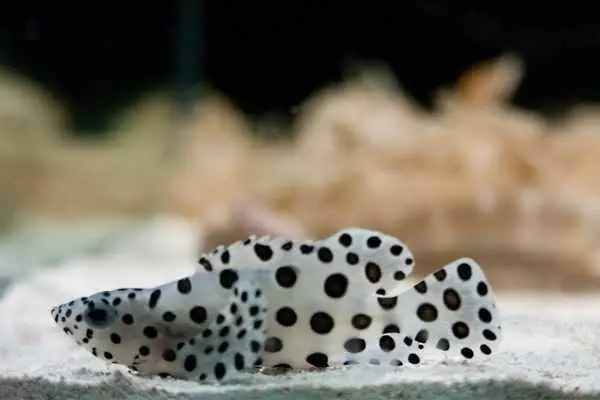
Livebearers like Mollies
Livebearers such as mollies and guppies are common freshwater aquarium fish. They are hardy, inexpensive, and fascinating because they readily breed in captivity, giving birth to live babies (hence the term “livebearers”). In the wild, you can find them in estuaries and other brackish waters (which refers to water that is not quite seawater and not quite saltwater, somewhere in between).
Because these fish have evolved to live in habitats with fluctuating salinities, people assume they could slowly acclimate to life in a saltwater tank. While, in theory, they CAN acclimate to full-strength seawater, the time involved (and the process) isn’t something a beginner should tackle. Oh, sure, their general hardiness and low cost have supported arguments in the past for using these fish as starter fish. But you’re looking for fish you can put into your SALTWATER aquarium. Not fish you need to work from a freshwater tank to a brackish tank and THEN place in your saltwater tank.
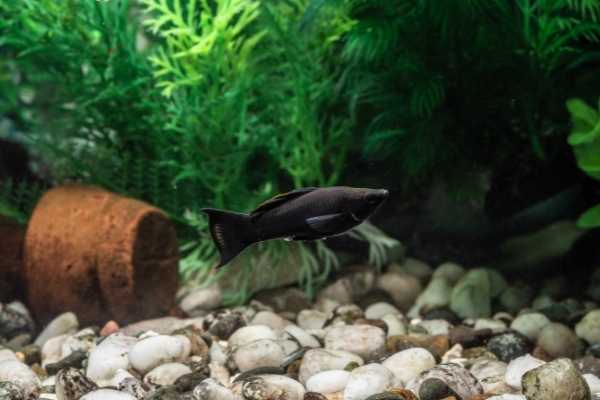
Damselfish
I see damselfish added as one of the most common starter fish. And, unfortunately, they meet most of the criteria. They’re inexpensive, hardy, and many species are bold and vibrantly colored. So why are they on this list? Because they most certainly are NOT peaceful.
Most species of damselfish are aggressive, territorial, and downright pugnacious fish. They will torment and harass your more delicate, prized fish. They can outlive (there’s no doubt of their hardiness) many of the fish in your tank. They’ll also outcompete them for the choicest morsels of food. And if you change your mind about keeping them? They can be an absolute nightmare to try and remove.
I learned this the hard way. I had a damselfish harass a pair of clownfish to the point of exhaustion.
Damselfish may be tempting because of their hardiness and low cost. And it doesn’t help that many local fish stores actually encourage using them as “disposable fish” to cycle a tank. Still, I encourage you to avoid them. If you MUST have some inexpensive, related fish, check out one of the chromis species. Damselfish are the number one family of starter fish to avoid.
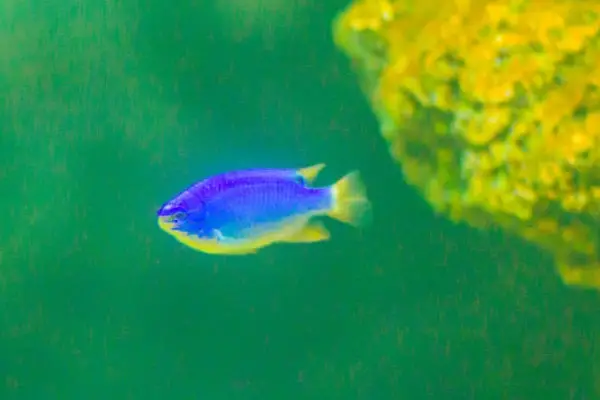
For More Information
Selecting the right starter fish for your saltwater tank involves research, careful planning, and patience. Just because your local fish store has a gorgeous fish in a tank DOESN’T make it a good choice for your home aquarium. I’d encourage you to exhibit some caution – even if the local fish store employee tells you a species is a good choice (especially in the case of Damselfish). Our ocean’s reefs are in trouble, and saltwater fish from those reefs are a precious resource. Resist the urge to make a spontaneous purchase. Always do your research first and know what they will be like when fully grown and defending a territory inside your tank.
If you need more convincing on these TERRIBLE starter fish, these YouTube videos should do the trick:
If you want to learn more about what it takes to start a successful saltwater aquarium, check out these books, including The New Saltwater Aquarium Guide, available on Amazon. Disclosure: if you buy the book from this link, I will earn a small commission from them (at no additional direct cost to you).

- 25 Best Beginner Saltwater Fish
- 5 Saltwater Fish for Beginners
- 7 Cool Saltwater Fish
- 21 Best Algae-Eating Saltwater Fish
- 11 Great low light corals
Written by Al B. Ulrich III
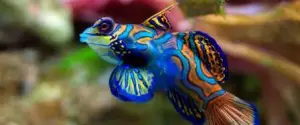
Leave a Reply